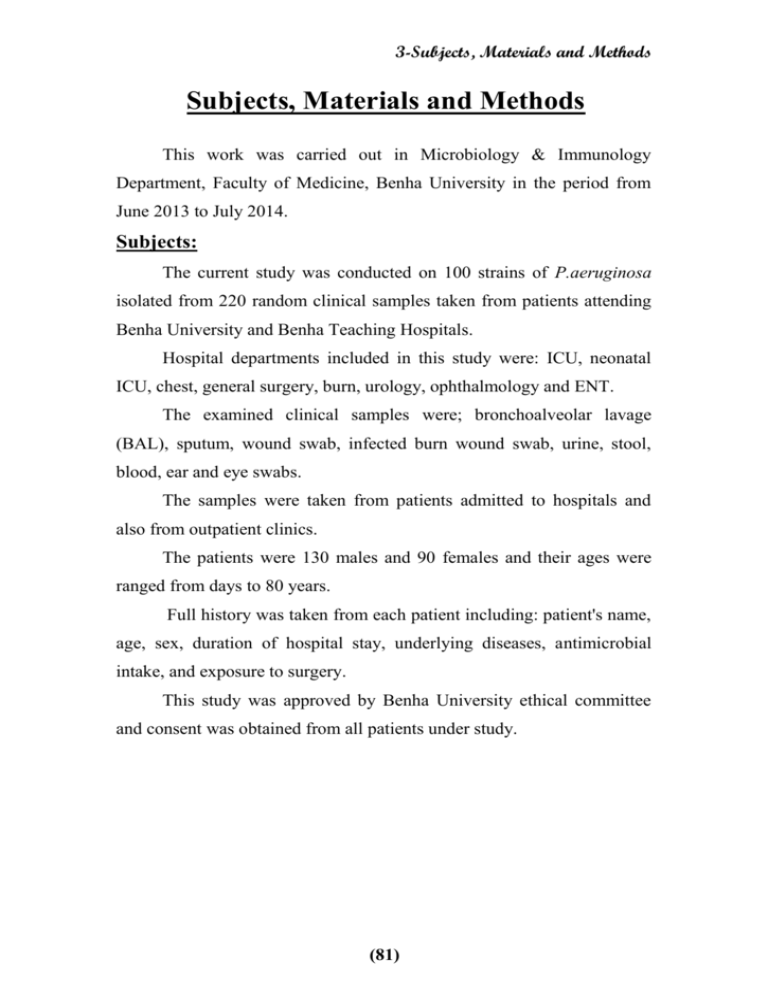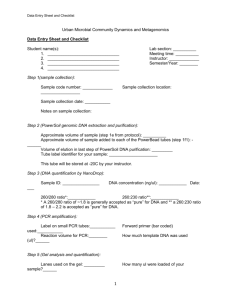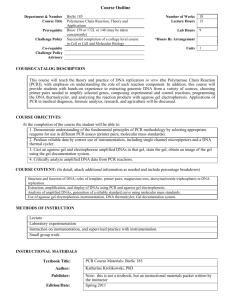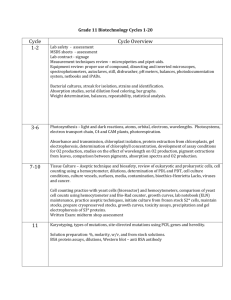Al Shaimaa Mahmmoud Mahmmoud Al Tabakh_materials methods
advertisement

3-Subjects, Materials and Methods Subjects, Materials and Methods This work was carried out in Microbiology & Immunology Department, Faculty of Medicine, Benha University in the period from June 2013 to July 2014. Subjects: The current study was conducted on 100 strains of P.aeruginosa isolated from 220 random clinical samples taken from patients attending Benha University and Benha Teaching Hospitals. Hospital departments included in this study were: ICU, neonatal ICU, chest, general surgery, burn, urology, ophthalmology and ENT. The examined clinical samples were; bronchoalveolar lavage (BAL), sputum, wound swab, infected burn wound swab, urine, stool, blood, ear and eye swabs. The samples were taken from patients admitted to hospitals and also from outpatient clinics. The patients were 130 males and 90 females and their ages were ranged from days to 80 years. Full history was taken from each patient including: patient's name, age, sex, duration of hospital stay, underlying diseases, antimicrobial intake, and exposure to surgery. This study was approved by Benha University ethical committee and consent was obtained from all patients under study. )81( 3-Subjects, Materials and Methods Materials A. Materials used for isolation and identification of P. aeruginosa: 1. Nutrient agar medium (Oxoid). 2. Pseudomonas Cetrimide Agar (Oxoid): Composition: (gm / liter) - Gelatin peptone 20 g/l. - Magnesium chloride 1.4 g/l. - Potassium sulfate 10.0 g/l. - Cetrimide 0.3 g/l. - Agar 13.6 g/l. Preparation: according to manufacturer's recommendations: 45.3g of Pseudomonas Cetrimide Agar was suspended in 1 litre of distilled water. 10ml of glycerol was added and boiled to dissolve completely. The medium was sterilized by autoclaving at 121°C for 15 minutes, cooled to approximately 50°C and poured into sterile Petri dishes. 3. Peptone water (Oxoid): base for sugar media. 4. Sugar fermentation media: 5 sugars were used (glucose, lactose, maltose, mannite and sucrose) (Sigma). 1% sugar concentration was added to pepton water. The sugar tube contains Andrade's indicator which change to pink if acid is produced and an inverted small tube (Durham's tube) to detect gas formation in its apex. 5. Nutrient gelatin medium: - Nutrient broth 1 liter (Sigma). - Gelatin 120 g (Sigma). )82( 3-Subjects, Materials and Methods 6. Gram's stain: It was used for microscopic examination of the isolated colonies from primary culture plates. 7. Oxidase detection test strips (Oxoid code BR0064A): Impregnated with the oxidase reagent (tetramethyl-p-phenylene diamine dihydrochloride) were used for detection of bacterial cytochrome oxidase enzyme. B. Materials used for antibiotic susceptibility testing: 1- Muller Hinton agar (Oxoid): Composition: (gm / liter) -Beef dehydrated infusion 300 g/l. -Casein hydrolysate 17.5 g/l. -Starch 1.5 g/l. -Agar 10 g/l. Preparation: according to manufacturer's recommendations: 38 g of Muller Hinton Agar was suspended in 1 litre of distilled water. Then boiled to dissolve the medium completely. The medium was sterilized by autoclaving at 121°C for 15 minutes, cooled to 50°C and poured into sterile petri dishes. 2- Antibiotic discs (Bioanalyse) with antimicrobial content matching Clinical Laboratory Standards Institute recommendations (CLSI) (Clinical Laboratory Standards Institute, 2012): The discs were stored at 2-8°C in an airtight container with a desiccant supplied by the manufacturer. The used antibiotic discs are listed in table (3-1) )83( 3-Subjects, Materials and Methods Table (3-1): Antibiotic discs that were used in the study Antibiotic Symbol Disc content Sensitive (mm) Intermediat e (mm) Resistant (mm) 1 Amikacin AK 30 ug ≥17 15-16 ≤14 2 Gentamycin CN 10 ug ≥15 13-14 ≤12 3 Tobramycin TOB 10 ug ≥15 13-14 ≤12 4 Piperacillin+tazo TPZ 100/10 ≥21 15-20 ≤14 bactam ug 5 Meropenem MEM 10 ug ≥19 16-18 ≤15 6 Imepinem IMP 10 ug ≥19 16-18 ≤15 7 Ceftazidime CAZ 30 ug ≥18 15-17 ≤14 8 Cefoperazone CEP 10 ug ≥21 16-20 ≤15 9 Cefotriaxone CRO 30 ug ≥21 14-20 ≤13 10 Cefotaxime CTX 30 ug ≥23 15-22 ≤14 11 Cefepime FEB 30 ug ≥18 15-17 ≤14 12 Aztreonam ATM 30 ug ≥22 16-21 ≤15 13 Amoxycillin/ AMC 30 ug ≥18 14-17 ≤13 clavulanic 2:1 acid 14 Ciprofloxacin CIP 5 ug ≥21 16-20 ≤15 15 Polymixin B PB 10 ug ≥12 - ≤11 16 Colistin CT 10 ug ≥11 - ≤10 )84( 3-Subjects, Materials and Methods 3- Sterile cotton swabs. 4- McFarland 0.5 turbidity standard: McFarland 0.5 standard was prepared as following (Cheesbrough, 2006): 1. A 1% v/v solution of sulfuric acid is prepared by adding 1ml of concentrated sulfuric acid to 99 ml of water and mixing. 2. A 1% w/v solution of barium chloride is prepared by dissolving 0.5 g of dihydrate barium chloride (BaCl2.2H2O) in 50 ml of distilled water. 3. 0.6 ml of the barium chloride solution is added to 99.4 ml of the sulfuric acid solution. 4. A small volume of the turbid solution is transferred to a screwcaped tube of the same type as used for preparing the test inoculum. 5. McFarland 0.5 standard tubes are stored in the dark at room temperature. They can be stable for 6 months. C. Materials used for phenotypic detection of MβL production: 1- Micropipette. 2- Filter papers (Whatman Filter paper). 3- Di sodium EDTA ( 0.5 M EDTA )(Hi-Media, India) solution was prepared by dissolving 18.61 g of EDTA in 100 ml of distilled water and adjusting pH 8.0 by using NaOH (Yong et al., 2002). )85( 3-Subjects, Materials and Methods D. Materials used for phenotypic detection of MβLs: 1- DNA extraction: Thermo Scientific GeneJET Genomic DNA Purification Kit #K0721 Table (3-2): Components of the DNA extraction kit. Proteinase K Solution 1.2 ml RNase A Solution 1 ml Digestion Solution 11 ml 24 ml Lysis Solution Wash Buffer I (concentrated) 10 ml 10 ml Wash Buffer II (concentrated) Elution Buffer (10 mM Tris-Cl, pH 9.0, 0.5 mM EDTA) GeneJET Genomic DNA Purification Columns pre-assembled with Collection Tubes Collection Tubes 30 ml 50 50 2- DNA amplification a- Master mix (Thermo Scientific, EU Lithuania) Maxima Hot Start PCR Master Mix (2X) #K1051 Table (3-3): components of Maxima hot start PCR master mix #K1051 100 rxns of 50 μl Component Maxima Hot Start PCR Master Mix (2X) Water, nuclease-free 2x1.25 ml 2x1.25 ml )86( 3-Subjects, Materials and Methods Maxima Hot Start PCR Master Mix (2X) composition: Maxima Hot Start Taq DNA polymerase is supplied in 2X Hot Start PCR buffer, 400 μM dATP, 400 μM dGTP, 400 μM dCTP, 400 μM dTTP and 4 mM Mg2+. b- Primers (Biosearch technologies, USA) (Ellington, 2007) Table (3-4): Sequence of primers that were used in this study. IMP family Imp-F 5'-GGA ATA GAG TGG CTT AAY TCT C-3' Imp-R 5'-CCA AAC YAC TAS GTT ATC T-3' VIM family Vim-F 5'-GAT GGT GTT TGG TCG CAT A-3' Vim-R GIM-1 Gim-F Gim-R SPM-1 Spm-F Spm-R 5'-CGA ATG CGC AGC ACC AG-3' 5'-TCG ACA CAC CTT GGT CTG AA-3' 5'-AAC TTC CAA CTT TGC CAT GC-3' 5'-AAA ATC TGG GTA CGC AAA CG-3' 5'-ACA TTA TCC GCT GGA ACA GG-3' SIM-1 Sim-F 5'-TAC AAG GGA TTC GGC ATC G-3' Sim-R 5'-TAA TGG CCT GTT CCC ATG TG-3' 3- DNA detection by agarose gel electrophoresis: Reagents: 1) 40x TAE (Tris acetate EDTA) buffer #V4281. (Promega, U.S.A) 2) Ethedium bromide solution (10mg/ml). (Promega, U.S.A) 3) Agarose. (Hopkins and Williams, England) )87( 3-Subjects, Materials and Methods 4) PCR marker (gene ruler 100 bp DNA ladder) (Fermentas) was used that contained the following bands: 100, 200, 300, 400, 500, 600, 700, 800, 900 and 1000 bp. Additional materials and equipment required: PCR thermal cycler (G-storm, United kingdom). Ultraspeed centrifuge (sigma, Germany). Thermomixer (peqlab TS 100, Germany). Agarose gel electrophoresis apparatus: (Biometra, Germany). Ultraviolet transilluminator: (Biometra ,Germany). Vortex (Shelton scientific, USA). Shaking water bath (Koterman, Germany). Ethanol (96-100%) (Adwic, Egypt). Pipettes and pipetts tips. Microcentrifuge tubes (1.5 ml). Disposable gloves. )88( 3-Subjects, Materials and Methods Methods A- Isolation and identification of P. aeruginosa: Cultivation of samples: Sputum, BAL, wound exudate, burn wound exudates,urine, stool, ear swabs, and eye swabs were cultured directly on Pseudomonas Cetrimide Agar. Blood samples were inoculated into blood culture bottles (Egyptian Diagnostic Media) then incubated at 37 °C for 7–14 days. Subcultures were done every 48 h on Pseudomonas Cetrimide Agar. The plates were incubated at 37°C for 1-2 days. Bacteria growing on the Pseudomonas Cetrimide Agar were further identified as follow: Identification of the isolated strains: 1- Characteristic Colony morphology and exopigments production: Demonstration of the presence of the pyocyanin is absolute confirmation of a strain as P. aeruginosa as the major diagnostic test (Govan, 1996). Nutrient agar slopes, were inoculated with the isolates, incubated at 37°C for 24 hours, and then at room temperature for one week. After incubation, they were examined for diffusible pigments. Pyocyanin is blue green and non-fluorescent (Govan, 1996). When pyocyanin production is absent or doubtful, P. aeruginosa, was characterized by other biochemical reactions according to table (35). )89( 3-Subjects, Materials and Methods Table (3-5): Distinguishing characters of clinically relevant Pseudomonas species (Govan, 1996) Pyocyanin Fluorescein P. aeruginosa P. cepacia P. pickettii P. stutzeri P. fluorescens P. putida + - + + + Growth at 42°C Gelatinase + + + ± - + + + - Maltose Lactose (oxidative) (oxidative) + + + - + + - 2- Microscopic examination of Gram stained film: Gram-stained films were made from the resulting colonies and examined microscopically. P. aeruginosa appears as Gram negative bacilli. 3- Oxidase test: Oxidase test was performed using Oxidase Detection Strips (Oxoid). - The colony to be tested is touched by the Oxidase Detection Strip. - The strip is observed for up to 5 seconds. - A deep blue/violet colour indicates a positive reaction. 4- Examination of flourescein production: (Govan, 1996) Fluorescein production is determined by visual examination of the plates under ultraviolet transilluminator. A positive result is the observance of a greenish-yellow fluorescent pigment in the agar. 5- Growth at 42 °C: (Cheesbrough, 2006) Slants of nutrient agar were inoculated with the isolates, incubated at 42°C for 24-48 hours and examined for the presence of growth. Growth at )90( 3-Subjects, Materials and Methods 42°C differentiates P. aeruginosa from the less commonly isolated pseudomonads, P. putida and P. fluorescens. 6- Examination of motility: (Collee et al., 1996) The isolate was grown in nutrient broth for 16 hours and examined for motility by the hanging drop technique. 7- Gelatin liquefaction test: (Collee et al., 1996) A stab cultures were made in the nutrient gelatin test tubes, they were incubated at 37°C for 24 hours. After incubation the nutrient gelatin cultures were removed and held at 4°C for 30 min before reading the results. Positive result is indicated by liquefaction of gelatin. 8- Sugar utilization tests: (Collee et al., 1996) The isolate was inoculated in sugar test tubes; pink colour indicate acid production and gas formation is detected in the apex of Durham's tube )91( 3-Subjects, Materials and Methods B- Antimicrobial susceptibility Antimicrobial susceptibility testing was performed for sixteen different antibiotics by the Kirby–Bauer disc diffusion method (Cheesbrough, 2006) 1. Using a sterile wire loop, 3-5 well-isolated colonies of similar appearance to the test organism were emulsified in 3-4 ml of sterile physiological saline. 2. The turbidity of the suspension was adjusted to match to the 0.5 McFarland turbidity standard. The standard was mixed immediately before use. 3. Using a sterile cotton swab, a plate of Mueller Hinton agar was inoculated: After dipping the swab in the suspension, the excess fluid was removed by pressing and rotating the swab against the side of the tube above the level of the suspension. Then the swab was streaked evenly over the surface of the medium in three directions, rotating the plate approximately 60° to ensure even distribution. 4. Petri dishes with the lid in place were left for 3-5 minutes to allow the surface of the agar to dry. 5. Using sterile forceps, the 16 antimicrobial discs were evenly distributed. The discs should be about 15mm from the edge of the plate and no closer than about 25 mm from disc to disc. 6. The plates were incubated aerobically at 35 °C for 16-18 h. 7. After overnight incubation, using a ruler on the underside of the plate, the diameter of each zone of inhibition was measured in mm. 8. The diameters were 'Intermediate/Moderately interpreted sensitive', )92( as 'Resistant', 'Sensitive (Susceptible) 3-Subjects, Materials and Methods according to CLSI published diameters table (3-1) (Clinical Laboratory Standards Institute, 2012). C- phenotypic detection of MβL production: 1. IMP-EDTA CDT: The IMP-EDTA CDT was performed as described by Yong et al., (2002). Test organisms were inoculated on Mueller Hinton agar plates. Two (10 μg) imipenem discs were placed on the plate, and appropriate amounts of 10 μL of EDTA solution were added to one of them. The inhibition zones of the imipenem and imipenem-EDTA discs were compared after 16 to 18 hours of incubation aerobically at 35°C. In the CDT, if the increase in inhibition zone with the imipenem and EDTA disc was ≥ 7 mm than the imipenem disc alone, it was considered as MβL positive. 2. IMP-EDTA DDST: The IMP-EDTA DDST was performed as described by Lee et al., (2003). Test organisms were inoculated on to plates with Mueller Hinton agar. An imipenem 10 μg disc was placed 20 mm (centre to centre) from a blank disc containing 10 μL of 0.5 M EDTA. Enhancement of the zone of inhibition in the area between imipenem and the EDTA disc in comparison with the zone of inhibition on the far side of the drug was interpreted as a positive result (Lee et al., 2003) )93( 3-Subjects, Materials and Methods Preparation of EDTA paper discs: Using an ordinary office two-hole puncher, paper discs with approximate diameter of 6.3mm., were punched out one by one from a sheet of paper. Precautions were taken to avoid overlapping of holes. Since the paper discs had a tendency to curl after punching, these were flattened by spreading them in a single-layer on a clean smooth surface then pressed by rolling a bottle repeatedly. The discs were placed in vials then autoclaved for 15 minutes and allowed to cool. Impregnation of disc The sterile discs were placed in sterile petri dishes (150 x 20mm) approximately 5mm apart. Using a mechanical pipettor with a fixed volume delivery of 10 ul, the discs were loaded with EDTA solution taking precautions that the tip was in light contact with the disc. Drying and storage Without covering the petri dishes, the discs were allowed to dry in a clean incubator at 35°C for 2-3 hours. After drying, 50 to 100 discs were placed in small sterile air-tight labeled containers. The discs were stored in a freezer at -20°C. Unopened containers were removed from the freezer 1 or 2 hours before use to equilibrate to room temperature before this is opened to minimize the amount of condensation that may occur when warm room air reaches the cold containers (Antonio-Velmonte et al., 1988). )94( 3-Subjects, Materials and Methods D. Genotypic detection of MβL genes by using Multiplex PCR : A- Genomic DNA extraction:The procedure was carried out according to manufacturer instructions as follows: Gram-Negative Bacteria Genomic DNA Purification Protocol: 1. Ethanol (96-100%) was added to the concentrated wash Buffer (WB) I and concentrated WB II prior to first use to prepare the working solution according to the following table: Table (3-6): Preparation of Wash Buffers WB I WB II 10 ml 10 ml Ethanol (96-100%) 30 ml 30 ml Total volume 40 ml 40 ml Concentrated wash solution 2. Bacterial cells (2x109) were harvested in a 1.5 or 2 ml microcentrifuge tube by centrifugation for 10 min at 5000 x g. The supernatant was discarded. 3. The pellet was resuspended in 180 μl of Digestion Solution. Proteinase K Solution 20 μl was added and mixed thoroughly by vortexing to obtain a uniform suspension. 4. The samples were incubated at 56°C in the thermomixer until the cells were completely lysed ∼30 min. 5. RNase A Solution 20 μl was added, mixed by vortexing and the mixture was incubated for 10 min at room temperature. )95( 3-Subjects, Materials and Methods 6. Lysis Solution 200 μl was added to the sample then Mixed thoroughly by vortexing for about 15 seconds until a homogeneous mixture was obtained. 7. 400 μl of 50% ethanol was added and mixed by pipetting or vortexing. 8. The prepared lysate was transferred to a GeneJET Genomic DNA Purification Column inserted in a collection tube. The column was centrifuged for 1 min at 6000 x g. The collection tube containing the flow-through solution was discarded. The GeneJET Genomic DNA Purification Column was placed into a new 2 ml collection tube. 9. 500 μl of WB I was added, and then the mixture was centrifuged for 1 min at 8000 x g. The flow-through was discarded and the purification column was placed back into the collection tube. 10. 500 μl of WB II was added to the GeneJET Genomic DNA Purification Column and then was Centrifuged for 3 min at maximum speed (≥12000 x g). Optional. If residual solution was seen in the purification column, the collection tube was emptied and the column was re-spined for 1 min. at maximum speed. The collection tube containing the flow-through solution was discarded and the GeneJET Genomic DNA Purification Column was transferred to a sterile 1.5 ml microcentrifuge tube. 11. 200 μl of elution Buffer was added to the center of the GeneJET Genomic DNA Purification Column membrane to elute genomic DNA, Incubated for 2 min at room temperature and centrifuged for 1 min at 8000 x g. For maximum DNA yield, the elution step was repeated with additional 200 μl of Elution Buffer. 12. The purification column was discarded and the purified DNA was used immediately in downstream applications or stored at -20°C. )96( 3-Subjects, Materials and Methods B- DNA amplification: The procedure was carried out according to manufacturer's instructions as follows: 1. Maxima Hot Start PCR Master Mix (2X) was gently vortexed after thawing. 2. Two PCR reactions were made for each sample. Reaction 1 (M1) was containing three primers (SIM-1, SPM-1, and GIM-1) while reaction 2 (M2) was containing two primers (IMP and VIM). 3. M1 PCR tube was containing the following components for each 50 μl reaction: Table (3-7): components of M1 PCR tube. Maxima Hot Start PCR Master Mix (2X) Each forward primer (SIM-1, SPM-1, and GIM-1) Each reverse primer (SIM-1, SPM-1, and GIM-1) 25 μl 1 μl (total 3 μl) 1 μl (total 3 μl) 5 μl Template DNA Water, nuclease-free 14 μl Total volume 50 μl )97( 3-Subjects, Materials and Methods M2 PCR tube was containing the following components for each 50 μl reaction: Table (3-8): components of M2 PCR tube. Maxima Hot Start PCR Master Mix (2X) 25μl Each forward primer (IMP-VIM) Each reverse primer (IMP-VIM) 1 μl (total 2 μl) Template DNA 1 μl (total 2 μl) 5 μl Water, nuclease-free 16 μl Total volume 50 μl 4. The samples were gently vortexed and spinned down. 5. The thermal cycler contains a heated lid, so no need to overlay the reaction mixture with mineral oil. 6. PCR was performed using the recommended thermal cycling conditions outlined below: Table (3-9): the program used in the thermal cycler (Ellington, 2007) Step Temperature (°C) Time 95°C 4 min Denaturation 95°C 30 s Annealing 46°C 30 s Extension 72°C 45 s Final extension 72°C 10 min Initial denaturation )98( Number of cycles 1 45 1 3-Subjects, Materials and Methods 7. PCR products were separated by 2% agarose gel electrophoresis. Agarose gel was stained by ethedium bromide and visualized by ultraviolet transilluminator. C- DNA detection by agarose gel electrophoresis: The procedure was carried out according to (Yilmaz et al., 2012). 1) The comb was placed across the rim of the casting tray to form sample wells. The height of the teeth was adjusted so that they penetrate the gel, about 1mm of gel was left between the teeth and remaining plate. 2) The working solution of TAE 1x buffer was prepared as follows: 25ml of 40x TAE buffer 975ml distilled water 3) The agarose solution with concentration of 2% was prepared as follows: 1.5gm agarose. 75 ml TAE buffer was added. The agarose was melted in water bath, then left to cool down to reach 60°C. 2μl ethedium bromide was added. 4) The liquid agarose was poured into the casting tray, air bubbles were avoided. Then the agarose was set into a gel for 30 minutes. 5) The comb was removed carefully from the edges of the casting tray. 6) The casting tray containing the agarose gel was put into the electrophoresis buffer tank and the gel was covered with 200 ml TAE buffer. )99( 3-Subjects, Materials and Methods 7) The DNA samples were prepared as follow: -15 μl of DNA were loaded into the gel (no need for addition of dye as master mix contains a dye for monitoring electrophoresis progress). -15 μl of DNA ladder was loaded directly into the gel as the ladder is ready to use (it is premixed with the 6X Orange DNA Loading Dye). 8) The lid was placed on the unit so that the cathode was nearest the sample wells, since the nucleic acid samples migrated towards the anode. 9) The power supply was connected. The length of the run was 40 minutes, at 80 volt and 300 mAmp. 10) The DNA was observed by fluorescence of ethedium bromide. The gel was transferred to the UV transilluminator. DNA bands were observed by using ultraviolet light at wave length 312 nm in a dark room. )100( 3-Subjects, Materials and Methods STATISTICAL ANALYSIS The data were recorded, tabulated, coded then analyzed using the computer program SPSS (Statistical package for social science) version 16 to obtain: Descriptive data: Descriptive statistics were calculated for the data in the form of Number and percent. Analytical statistics: A- In the statistical comparison between the different groups, the significance of difference was tested using one of the following tests:1- Inter-group comparison of categorical data was performed by using chi square test (X2-value), 2- Z test for proportions is used to compare one outcome in two different groups. P value <0.05 is considered statistically significant, P value <0.001 is considered highly significant in all analyses and P value ˃ 0.05 is considered insignificant. B- The sensitivity and specificity of IMP EDTA CDT and IMP EDTA DDST in comparison with PCR were examined using receiver operating curve (ROC curve) analysis to determine the best diagnostic method. C- Kappa test: The measure of the level of agreement between two categorical measures. Value of kappa Strength of agreement <0.20 Poor 0.21–0.40 Fair )101( 3-Subjects, Materials and Methods 0.41–0.60 Moderate 0.61–0.80 Good 0.81–1.00 Very good D- Positive predictive values (PPV): the proportion of people with a positive test who have the disease. E- Negative predictive values (NPV): the proportion of people with a negative test who are free of disease F- Odds ratio (OR), confiedence interval (CI) are used to assess risk factors. Odds: the ratio of the number of times an event happens to the number of times it does not happen in a group of patients. Odds ratio: the odds of an event happening in one group divided by the odds in a different group. CI: the range around a study’s result within which we would expect the true value to lie. )102(






